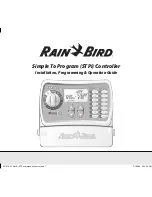
framing, or overrun error is detected. These errors are only flagged for RS-232/RS-485/RS-422
data coming into the SDM-SIO1A.
These types of errors are usually caused by a connection issue or sometimes a mismatch of the
interface type, baud rate, or data format (parity, etc.).
Some confusion can be caused in debugging such problems because it is possible for the
communication to partly work even with such mismatches, for instance:
l
Mismatched parity settings will often show many valid characters interspersed with invalid
characters or “?” which the SDM-SIO1A will store if there are parity errors.
l
Incorrect connections resulting in inverted signals can also result in some valid characters
being received, but usually with no normal data.
l
An RS-485 receiver can often read data transmitted at RS-232 levels, although the reverse
will not work.
Where
you
see
some
serial
activity
which
is
invalid,
check
the
documentation
and
configuration
of
both
the
device
the
SDM-SIO1A
is
connected
to
and
the
data
logger.
Also,
check
the
wiring
carefully.
In
the
case
of
RS-485/RS-422,
there
is
also
a
big
risk
of
confusion
being
caused
by
there
being
several
different
ways
of
labe
l
ling
the
transmit
and
receive
lines.
Some
devices
may
even
have
reversed
meaning
for
some
lines—for
example,
A
and
B
are
sometimes
used
and
transposed.
Generally,
for
these
lines
it
is
safe
to
try
swapping
them
around
if
there
is
doubt
as
to
whether
the
same
terminology
is
being
used.
If
you
are
sure
the
configuration
and
wiring
of
the
data
logger
and
serial
device
is
correct,
it
is
possible
to
check
what
the
data
logger
thinks
it
is
transmitting
and
the
data
it
is
receiving
by
connecting
to
the
data
logger
with
a
computer
and
entering
the
terminal
mode.
You
can
then
use
the
“W”
command
to
“sniff”
data
passing
to
and
fro
through
any
serial
port
including
SDM-SIO1A
ports.
The
data
can
be
displayed
in
ASCII
or
binary
(HEX)
modes.
This
is
a
powerful
tool
for
checking
programming
errors
and
the
response
of
remote
devices.
See
the
data
logger
manual
for
more
information
on
terminal
mode.
Either
during
setup
or
at
some
point
later,
it
is
possible
that
erratic
communication
errors
may
be
seen.
The
normal
cause
of
this
will
be
noise
pickup,
especially
for
long
cable
runs.
The
likelihood
of
such
errors
can
be
reduced
by
using
screened
cable,
making
sure
there
is
a
ground
connection
between
the
two
systems,
and
installing
termination
resistors
for
RS-485/RS-422
links.
It
is
worth
noting
that
textbooks
often
say
termination
resistors
are
only
needed
for
long
cables
at
very
high
baud
rates,
which
is
true
when
considering
noise
caused
by
reflections.
However,
even
a
single
termination
resistor
at
one
end
of
the
link
can
suppress
induced
noise
caused
by
pickup
from
SDM-SIO1A and SDM-SIO4A Serial Input/Output Modules
28














































